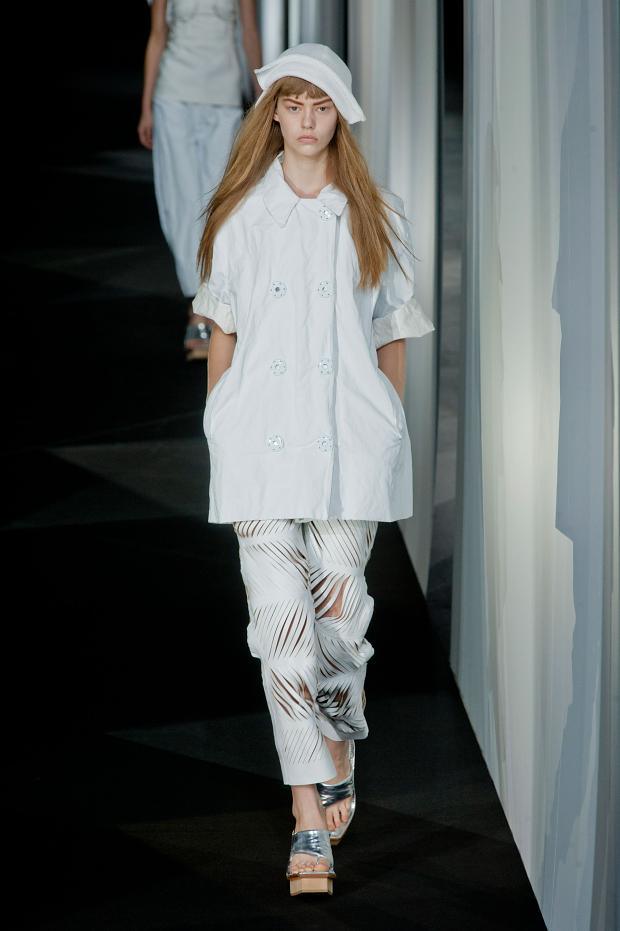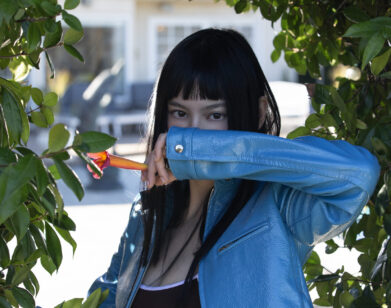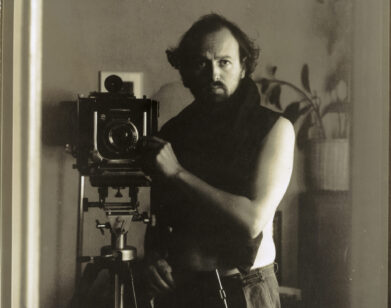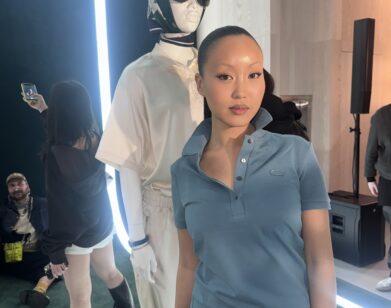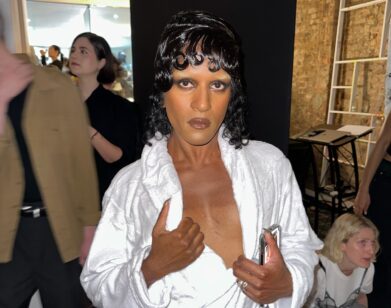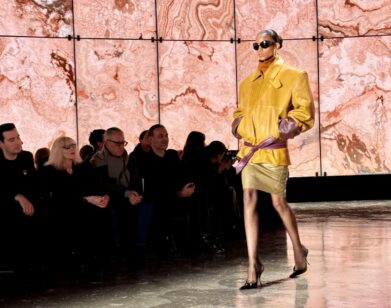School, Skate, and Seabreeze as Paris Travels
Be it street or highway, Parisian designers have bitumen on the brain, as their transportive collections call upon myriad roadside references, from skate park to “stepper” street dancing, maritime motifs, and the gamut of escapist traveling associations in between. Some strayed directly into stereotypes, while others triumphed.
Amongst the latter, the 25-year-old Australian-Chinese designer Yang Li showed his first on-schedule collection in the wings of the contemporary art museum Jeu du Paume, sending out his first model in a frayed-edge ball skirt, a black perfecto clutched to her bare breast. This romantic, considered gesture preluded an elegant and brutal outing inspired by skateboarding and ’50s New Look, which proffered an intriguing balance of exquisite materials cut in workwear and evening silhouettes. Despite a splash of dark camo, the season’s flat, smooth textiles held Li’s exaggerated structures in a palette of bright white, black, taupe, and forest green—each styled in nonchalant layers, with straps and belts floating carefree. A zipped basque skirt in aged white crocodile was the collection’s most sensual proposal, while slick calfskin dungarees felt like a luxurious ’90s revival and the epitome of Li’s obsession with rendering the commonplace precious.
Marc Jacobs will need to pull more than a rabbit out of his Louis Vuitton hat tomorrow morning, if he is to trump the spectacle that was Rick Owens’ Spring ’14 show. The American designer’s team scoured his homeland for months to cast four “stepping” troupes from college sororities, to transform his runway show into a veritable dance battleground in passages of black, white, sand, and chocolate-colored silhouettes modeled solely on their ample, athletic forms. There was not a waif in sight as the 40 dancers synchronized an extraordinary performance, slapping and stamping across the runway, their teeth-gnashing expressions startling more than a few editors in the front row. Owens’ collection gelled with the fierce, choreographed routines in its sculptural, pragmatic beauty—he laced the leather jackets at the hips and cut his shift dresses and shorts in baggy drapes with lantern sleeves or wide arm holes, tied at times with obi belts, bandanas, and habit-like headscarves. In a momentous finale, the four teams united in a scrum-like conga line, which in itself represented an act of cooperative compromise. Rick named the collection “Vicious”—fitting, considering the gravity of this assault on traditional beauty ideals.
With a return to the haute couture calendar in June under their belts (celebrating their 20th anniversary next year), Viktor Horsting and Rolf Snoeren seem to have definitively separated their Viktor & Rolf ready-to-wear collection from the fantasy and spectacle of recent years. After couture’s brilliant Zen garden setting, the duo paved the Tuileries tent of their Spring ready-to-wear show in black and white brick patterns, calling to mind (and ear) Pink Floyd’s seminal album The Wall, from which covers blasted over the airwaves mixed through into Britney Spears’ “…Baby One More Time.” The scene was set, unsurprisingly, for a schoolgirl-inspired collection of short and sweet separates that juggled various uniform references—the kilt, the blazer, and the white blouse, to be exact. Opening the show with promise, a piped blazer wrapped around the bust and slashed away with a single sleeve; however, subsequent variations felt flat and clichéd, punked out in spike studs and safety-pin hems. The argyle motif picked out in glass beads and collegiate crests in broderie anglaise were a more delicate touch, yet weren’t enough to make the grade.
Also forcing a single, staunch throughline was Acne Studios, whose dockside damsels wore knitted bonnets by Stephen Jones atop their nautical-but-nice ensembles. Jonny Johansson, the brand’s creative director, cited a Swedish ode to the sea as his inspiration, and had The Hives’ singer Pelle Almqvist belt it out live before the show. Johansson’s pared-down designs put Acne’s denim heritage back on their ready-to-wear radar, an element that has been missing for several larger-than-life seasons of experimentation for the brand. It felt like an honest return to what they do best: superior workwear subverted by print, proportion and playful styling. With low-slung, giant skater belts and square-toed sandals, Acne’s Spring sailor wore crunchy poplins and bull denim, cut in parkas and peacoats in an aquatic palette shot through by pops of high-visibility red and yellow. Anchor embroideries aside, it was a relevant and covetable outing that will surely translate to retail success, not least when racked in their new Paris store (their third), which opened last week along the Left Bank’s Quai Voltaire.
After three decades of questioning, investigative, and groundbreaking fashion design practice, Rei Kawakubo doesn’t need to offer much explanation for her continuing monologue chez Comme des Garçons. The five-minute encore applause from the industry’s front-row luminaries at her Spring show says enough. Today, with an empire at her back, Rei need not propose the next season’s “wardrobe” in digestible forms, but rather continue her stalwart approach to her art, with all the theatrics and ceremony it deserves in its position as an international marker for the true avant-garde. For her Spring show, Kawakubo had a rough ramped catwalk installed, upon which each model slowly perambulated—a pendulum spotlight swinging in measured arcs above their head. The shadow play this created was only one layer of the disjointed beauty of the show; a scratching vinyl soundtrack was another, with deafening silences cutting any idle chatter between silhouettes. The garments themselves were architectures sprung from a library of associations with home and women, from a diaper-like bubble dress stuffed with its own ruffled skirt to a nylon teddy bear, static amongst cascades of frilly pink Tyvek. As often as these pieces looked like swallowing their wearer whole, did they seem to open invitingly—as in the disc-like hoop skirt that slashed underneath to allow the legs through, or a papery dress that wove around the torso like a collapsible camp tent. Oddly, one could check off a slew of the season’s trends if you really wanted to (pleats were there, girlish bows, pink, tulle). We wouldn’t, though, for fear of having entirely missed the boat.

